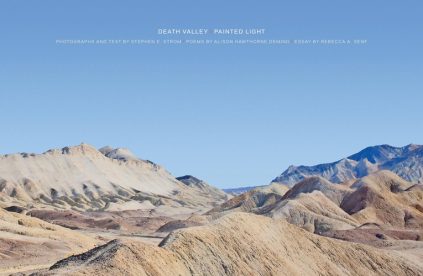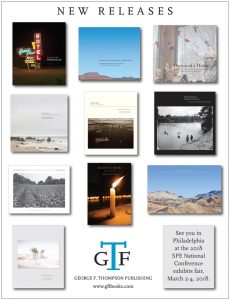-
Archives
- March 2025
- February 2025
- April 2024
- June 2022
- April 2021
- April 2020
- October 2019
- July 2019
- April 2018
- October 2017
- April 2017
- July 2015
- January 2015
- September 2014
- May 2013
- April 2013
- February 2013
- January 2013
- November 2012
- October 2012
- September 2012
- April 2012
- January 2012
- September 2011
- August 2011
- July 2011
- June 2011
- May 2011
- March 2011
- January 2011
- November 2010
- September 2010
- July 2010
- May 2010
- March 2010
- January 2010
- November 2009
- September 2009
- July 2009
- May 2009
- March 2009
- January 2009
- November 2008
- September 2008
- July 2008
- May 2008
-
Meta
DEATH VALLEY: Painted Light
DEATH VALLEY: Painted Light
Photography and text by Stephen Strom
Poetry by Alison Hawthorne Deming
Essay by Rebecca A. Senf, PhD
George F. Thompson Publishing
2016
Death Valley is the lowest, driest and hottest area in North America. Located about 150 miles west of Las Vegas near the border of California and Nevada, it straddles an area of about 3,000 square miles (7,800 km). A land of extremes and contrasts, it includes a mountain that towers over 11,000 feet, and an oasis that provides habitat for the endangered Devils Hole Pupfish (Cyprinodon diabolis). Designated a national park in 1994, its rugged, yet otherworldly beautiful landscape now attracts over 1 million visitors per year.
Attracted by the distinctive topography and light of Death Valley, Stephen Strom began traveling regularly there some thirty-five years ago. His abstract, almost pointillist compositions reveal the patterns and effects of geologic forces over millennia, taking in both the vast sweep of land and sky and the details of the volcanic cinder cones, sand dunes, dry lakes and salt pans, colorful badlands and canyons, and pine-studded mountains that give the area its distinctive and varied character.
His images are complemented by Alison Hawthorne Deming’s sequence of poems that are as luminous and detailed as the images themselves. Rebecca Senf’s perceptive essay situates his work within the canon of those who have inspired and mentored him, including Ansel Adams, Harry Callahan, Keith McElroy, Eliot Porter, Frederic Sommer, and Max Yavno.
Stephen Strom is both a research astronomer and fine art photographer. His work, largely interpretations of landscapes, has been exhibited throughout the United States and is held in several permanent collections including the Center for Creative Photography in Tucson, Arizona, the University of Oklahoma Art Museum, the Mead Museum, Amherst, Massachusetts, and the Museum of Fine Arts, Boston. He has published six previous books of photography, including three with the University of Arizona Press, Secrets from the Center of the World, with Muscogee poet Joy Harjo (1989), Sonoita Plain: Views from a Southwestern Grassland, a collaboration with ecologists Jane and Carl Bock (2005), and Tseyi: Deep in the Rock Reflections on Canyon de Chelly, with Navajo poet Laura Tohe (2005).
Alison Hawthorne Deming is an award-winning poet and essayist. She is the author of eleven books of nonfiction and poetry, the most recent of which are Zoologies: On Animals and the Human Spirit (Milkweed, 2014) and Stairway to Heaven, forthcoming from Penguin in 2016. Her many awards include the Walt Whitman Award of the Academy of American Poets, two National Endowment for the Arts Fellowships, a Wallace Stegner Fellowship at Stanford University (1987-1988), and a 2015 fellowship from the John Simon Guggenheim Foundation. She is the Agnese Nelms Haury Chair of Environment and Social Justice at the University of Arizona, Tucson.
Rebecca A. Senf, PhD is the Norton Family Curator of Photography, a joint appointment at the Center for Creative Photography, and the Phoenix Art Museum. Her recent exhibitions include Debating Modern Photography: the Triumph of Group f/64, Richard Avedon: Photographer of Influence, Edward Weston: Mexico, Face to Face: 150 Years of Photographic Portraiture, and Exposing Time: Capturing Change Through Photography. Senf is the author, with Stephen J. Pyne, of Reconstructing the View: The Grand Canyon Photographs of Mark Klett and Byron Wolfe (University of California Press, 2011).



